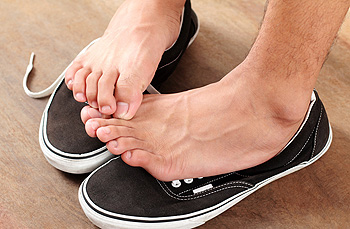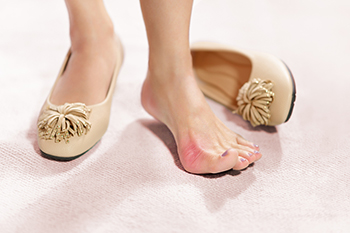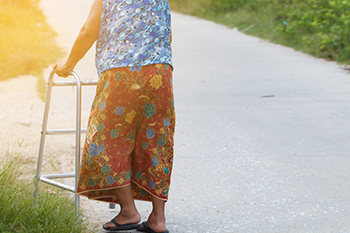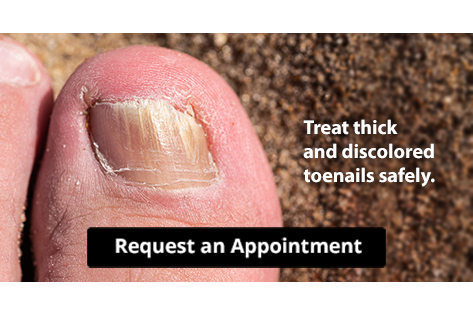Items filtered by date: July 2023
Stop Your Toenail Fungus
Causes of Big Toe Joint Pain

Big toe joint pain can be caused by various conditions, like arthritis, bunions, gout, sesamoiditis, or turf toe. These conditions can lead to stiffness, swelling, and a grinding sensation. Even though the toe joints are small, they support a significant amount of body weight and play a crucial role in foot function. The most common form of arthritis affecting the big toe is osteoarthritis, which results from tissue erosion between bones and joints. It makes it difficult to straighten the toe and causes pain while standing or walking. Bone spurs can also develop on the top of the big toe, leading to pain, particularly when wearing shoes. Bunions, characterized by a large bump on the joint of the big toe, are deformities that cause the toe to shift towards the smaller toes. They can be caused by things such as genetics, tight shoes, or rheumatoid arthritis. Finding comfortable shoes becomes challenging, and wearing them can be painful. Bunions result in redness, irritation, and swelling on the side of the big toe. Gout, another type of arthritis, occurs when uric acid builds up in the blood, forming crystals that deposit into a joint, often affecting the big toe joint. Uric acid is a waste product that accumulates when purines, found in certain foods like red meat, seafood, and alcohol, are broken down. Failure to eliminate uric acid through the kidneys can lead to gout, causing intense pain, swelling, redness, and heat in the joint. Since big toe pain can have various causes, it is suggested that you consult a podiatrist for an examination, a diagnosis, and the appropriate treatment options.
Toe pain can disrupt your daily activities. If you have any concerns, contact Richard P. Jacoby, DPM of Extremity Health Centers. Our doctor can provide the care you need to keep you pain-free and on your feet.
What Causes Toe Pain?
Most severe toe pain is caused due to a sports injury, trauma from dropping something heavy on the toe, or bumping into something rigid. Other problems can develop over time for various reasons.
Toe pain can be caused by one or more ailments. The most common include:
- Trauma
- Sports injury
- Wearing shoes that are too tight
- Arthritis
- Gout
- Corns and calluses
- Hammertoe
- Bunions
- Blisters
- Ingrown toenails
- Sprains
- Fractures (broken bones)
- Dislocations
When to See a Podiatrist
- Severe pain
- Persistent pain that lasts more than a week
- Signs of infection
- Continued swelling
- Pain that prevents walking
Diagnosis
In many cases the cause of toe pain is obvious, but in others, a podiatrist may want to use more advanced methods to determine the problem. These can range from simple visual inspections and sensation tests to X-rays and MRI scans. Prior medical history, family medical history, and any recent physical traumatic events will all be taken into consideration for a proper diagnosis.
Treatment
Treatments for toe pain and injuries vary and may include shoe inserts, padding, taping, medicines, injections, and in some cases, surgery. If you believe that you have broken a toe, please see a podiatrist as soon as possible.
If you have any questions please feel free to contact one of our offices located in Scottsdale and Buckeye, AZ . We offer the newest diagnostic tools and technology to treat your foot and ankle needs.
Why Your Feet May Smell Bad

When a distinct foul odor emanates from your shoes or feet, it can be an indication of an infection. Bacteria thrive in warm, moist atmospheres, such as the inside of a shoe or between the toes. Two types of bacteria are common causes of foot odor as they interact with the sweat on the feet and produce chemicals that smell bad. Isovaleric acid emanates a cheesy, sweaty foot odor, while propionic acid projects a sour smell. In addition, brevibacteria, which eats the dead skin on the toes, can produce a gas that also smells sour. Socks and shoes that don’t allow sweat to evaporate from the skin can be another cause of foot odor. A fungal infection, or tinea, frequently termed athlete’s foot, can also result in foot odor. The first line of defense against smelly feet is developing a daily foot care and hygiene regime. Wash and dry the feet thoroughly, especially between the toes. Allow your shoes and socks to dry completely between wearings. If foot odor is an ongoing problem for you, it is suggested that you make an appointment with a podiatrist for an evaluation and possible treatment options.
Everyday foot care is very important to prevent infection and other foot ailments. If you need your feet checked, contact Richard P. Jacoby, DPM from Extremity Health Centers. Our doctor can provide the care you need to keep you pain-free and on your feet.
Everyday Foot Care
Often, people take care of their bodies, face and hair more so than they do for their feet. But the feet are a very important aspect of our bodies, and one that we should pay more attention to. Without our feet, we would not be able to perform most daily tasks.
It is best to check your feet regularly to make sure there are no new bruises or cuts that you may not have noticed before. For dry feet, moisturizer can easily be a remedy and can be applied as often as necessary to the affected areas. Wearing shoes that fit well can also help you maintain good foot health, as well as making it easier to walk and do daily activities without the stress or pain of ill-fitting shoes, high heels, or even flip flops. Wearing clean socks with closed shoes is important to ensure that sweat and bacteria do not accumulate within the shoe. Clean socks help to prevent Athlete’s foot, fungi problems, bad odors, and can absorb sweat.
If you have any questions please feel free to contact one of our offices located in Scottsdale and Buckeye, AZ . We offer the newest diagnostic and treatment technologies for all your foot and ankle needs.
The Definition of a Bunion

A bunion is a progressive bone disorder and is considered to be a deformity. It is defined as a bony lump that develops on the side of the big toe and may change the structure of the foot. Severe bunions may cause the other toes to shift toward each other, and larger shoes may need to be purchased. A common reason why people get bunions can be from the shoes that are worn. If the shoe does not have adequate room for toes to move freely in, they may gradually become cramped, and a small bump may be noticeable. Bunions may also happen from genetic reasons, or possibly from having flat feet or low arches. Temporary relief may be found when a protective pad is placed over the bunion, in addition to wearing shoes that fit correctly. If you have developed a bunion, it is suggested that you visit a podiatrist who can provide a more permanent solution, which may include surgery for removal.
If you are suffering from bunions, contact Richard P. Jacoby, DPM of Extremity Health Centers. Our doctor can provide the care you need to keep you pain-free and on your feet.
What Is a Bunion?
A bunion is formed of swollen tissue or an enlargement of boney growth, usually located at the base joint of the toe that connects to the foot. The swelling occurs due to the bones in the big toe shifting inward, which impacts the other toes of the foot. This causes the area around the base of the big toe to become inflamed and painful.
Why Do Bunions Form?
Genetics – Susceptibility to bunions are often hereditary
Stress on the feet – Poorly fitted and uncomfortable footwear that places stress on feet, such as heels, can worsen existing bunions
How Are Bunions Diagnosed?
Doctors often perform two tests – blood tests and x-rays – when trying to diagnose bunions, especially in the early stages of development. Blood tests help determine if the foot pain is being caused by something else, such as arthritis, while x-rays provide a clear picture of your bone structure to your doctor.
How Are Bunions Treated?
- Refrain from wearing heels or similar shoes that cause discomfort
- Select wider shoes that can provide more comfort and reduce pain
- Anti-inflammatory and pain management drugs
- Orthotics or foot inserts
- Surgery
If you have any questions, please feel free to contact one of our offices located in Scottsdale and Buckeye, AZ . We offer the newest diagnostic and treatment technologies for all your foot care needs.
How Household Changes Can Help to Prevent Falling

Research has shown that approximately 25 percent of adults fall every year. Many of these people can experience consequences that can range from breaking a bone to the inability to complete daily activities as a result of having a fear of falling. Falling can happen from having an unsafe living environment, existing medical conditions, or a change in eyesight. There are simple methods that can be implemented which can help to reduce the number of falls. Installing grab bars in the toilet and shower area and using a non-skid bathmat are effective fall prevention techniques. Additionally, removing worn rugs and improving lighting in the household can make the home safer. Many elderly people choose to stretch and exercise daily, which is helpful in keeping the body strong, and possibly helping to prevent falling. If you would like additional knowledge about how falling can affect the feet and how to avoid this, it is suggested that you confer with a podiatrist who can offer you useful tips.
Preventing falls among the elderly is very important. If you are older and have fallen or fear that you are prone to falling, consult with Richard P. Jacoby, DPM from Extremity Health Centers. Our doctor will assess your condition and provide you with quality advice and care.
Every 11 seconds, an elderly American is being treated in an emergency room for a fall related injury. Falls are the leading cause of head and hip injuries for those 65 and older. Due to decreases in strength, balance, senses, and lack of awareness, elderly persons are very susceptible to falling. Thankfully, there are a number of things older persons can do to prevent falls.
How to Prevent Falls
Some effective methods that older persons can do to prevent falls include:
- Enrolling in strength and balance exercise program to increase balance and strength
- Periodically having your sight and hearing checked
- Discuss any medications you have with a doctor to see if it increases the risk of falling
- Clearing the house of falling hazards and installing devices like grab bars and railings
- Utilizing a walker or cane
- Wearing shoes that provide good support and cushioning
- Talking to family members about falling and increasing awareness
Falling can be a traumatic and embarrassing experience for elderly persons; this can make them less willing to leave the house, and less willing to talk to someone about their fears of falling. Doing such things, however, will increase the likelihood of tripping or losing one’s balance. Knowing the causes of falling and how to prevent them is the best way to mitigate the risk of serious injury.
If you have any questions, please feel free to contact one of our offices located in Scottsdale and Buckeye, AZ . We offer the newest diagnostic and treatment technologies for all your foot care needs.

